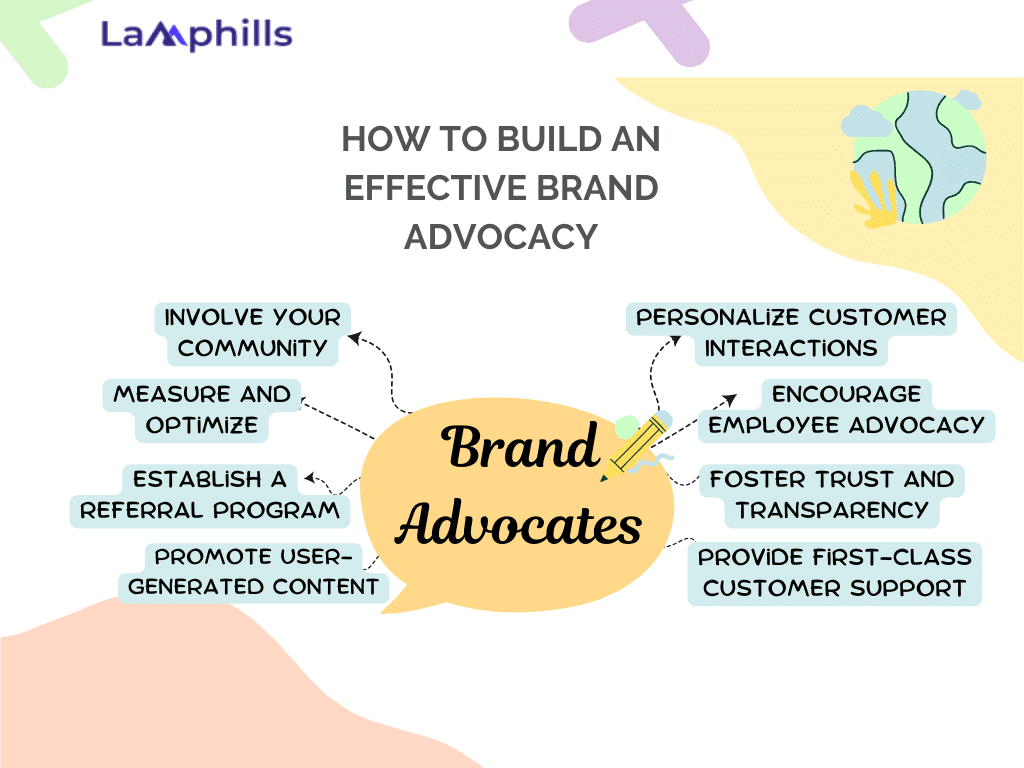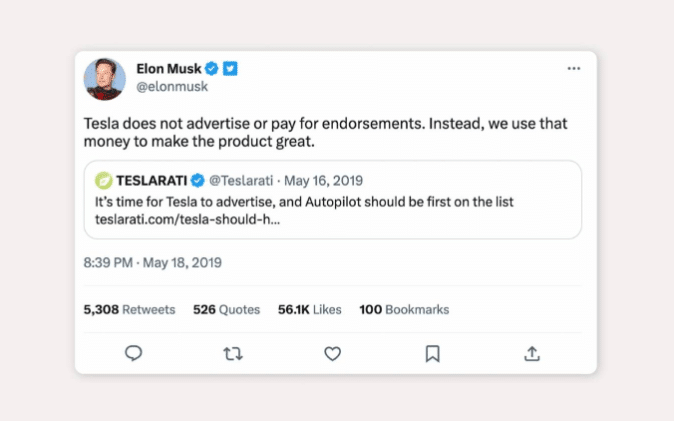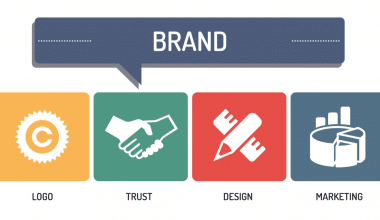When you see that your friend, favourite celebrity, or influencer on social media is screaming about a new brand they found and is overwhelmed with carefully chosen advertisements and influencer endorsements, it excites you as a person and sparks your curiosity. Everyone has experienced the joy of finding a brand that offers high-quality goods and services, delivered by top-notch personnel, and sharing that discovery with friends and family. Growing a brand involves more than simply marketing; it also entails assembling enthusiastic supporters who passionately promote your company. However, what exactly is brand advocacy? This is what I will be sharing with you, as detailed information on how you can build one in 2024.
Key Takeaways
- Brand advocacy is more than just customer satisfaction; it involves customers becoming enthusiastic promoters of a brand, often through word-of-mouth referrals, social media mentions, and positive reviews.
- Building effective brand advocacy involves several key steps: promoting user-generated content, establishing a referral program, measuring and optimizing your advocacy efforts, involving your community, personalizing customer interactions, encouraging employee advocacy, fostering trust and transparency, and providing first-class customer support.
- Successful brand advocacy campaigns leverage genuine customer experiences to build credibility and encourage more people to use their products or services.
What is Brand Advocacy?
Brand advocacy is the practice where satisfied customers become enthusiastic promoters of a brand. These individuals don’t just use a product or service; they actively endorse it to others. Their promotion can take various forms, including word-of-mouth referrals, social media mentions, positive reviews, and participation in brand-related events or campaigns.
Brand advocacy is more than just happy customers. It draws on the strong emotional bond that consumers have with a brand, encouraging them to naturally share their good experiences. Because it is viewed as genuine and reliable, this type of promotion is extremely valuable—often more so than traditional advertising.
In a nutshell, brand advocacy is the process of converting consumers into passionate supporters who willingly and enthusiastically promote your brand.
Research conducted by Lamphill (2023) revealed that a whopping 90% of consumers trust recommendations from friends and family over all other forms of advertising. That’s right, people trust the opinions of their peers far more than polished marketing messages.
Who are Brand Advocates?
Brand advocates are customers who have had exceptional experiences with your brand and feel a strong emotional connection to it. These individuals are not just satisfied customers; they are delighted and enthusiastic about what your brand offers. Here are some characteristics that typically define brand advocates:
- Loyal Customers: Brand advocates consistently choose your brand over competitors and have a high level of trust in your products or services. Their loyalty is rooted in positive experiences and a deep emotional connection with your brand. Consider Apple customers who not only buy Apple products but also eagerly await new releases, attend Apple events, and passionately defend the brand against criticism.
- Frequent Referrers: They refer your brand to their friends, family, and social networks. They are vocal about their positive experiences and are eager to share them with others. This word-of-mouth promotion is incredibly influential because it comes from a trusted source.
- Engaged Community Members: Brand advocate participates in social media discussions, attend events, contribute user-generated content, and interact with other customers. Their engagement helps build a vibrant and supportive community around your brand. I once joined a fitness brand’s online community where members shared their workout routines and progress. The sense of support was encouraging, and many of us became vocal advocates, recommending the brand’s products and programs to others.
- Positive Reviewers: They willingly share their satisfaction on review sites, social media, and other platforms. Their feedback not only boosts your brand’s reputation but also influences potential customers.
- Product Innovators: Brand advocates often provide valuable feedback and suggestions for product improvements. Their deep connection with your brand means they care about its success and want to see it evolve. Their insights can be a goldmine for innovation and continuous improvement.
What are the Objectives of Brand Advocacy?
In the world today, where customers are bombarded with marketing messages and commercials, brand advocacy is particularly noteworthy. Recommendations from friends and family are significantly more trusted by the public than conventional advertising. Customers are more likely to trust recommendations from friends and family than from advertisements.
Brand advocacy seeks to accomplish several goals:
- Increase brand Awareness: By reaching out to new populations that traditional marketing might miss, advocates help your company become more well-known. Sincere recommendations from their peers can draw in clients who are more receptive to recommendations than marketing.
- Enhance Customer Loyalty: Advocates who have a deep bond with your business are more likely to stick around as devoted patrons. They offer insightful criticism that can be used to enhance your goods and services and increase customer loyalty.
- Boost Sales and Revenue: Word-of-mouth recommendations and favourable reviews from advocates help to increase sales. Prospects can become customers thanks to their recommendations, frequently for less money than through conventional marketing means.
- Strengthen Brand Reputation: Through their endorsements and testimonies, advocates contribute to the development of a favourable brand image. Their authentic experiences can enhance your brand’s credibility and trustworthiness in the eyes of potential customers.
- Encourage Innovation: Active supporters frequently offer insightful commentary and advice that can be used to pinpoint areas in which innovation can occur. Their opinions can help direct service improvements and product development, ensuring that your offers satisfy customers.
- Keep a Company Ahead of the Competition: A company stays ahead of its rivals when it becomes the talk of the town thanks to a groundbreaking product or memorable marketing effort.
- Boosts Content Creation: Unbeknownst to them, advocates serve as an organization’s marketers. They are generating free publicity for the company each time they share an article or upload a video. Getting visitors to write blog posts is a great way to increase brand recognition.
How to Build an Effective Brand Advocacy

Building brand advocacy requires a strategic approach focused on creating exceptional customer experiences and fostering genuine connections. Here are some key steps:
#1. Promote User-Generated Content
User-generated content (UGC) is an effective instrument for promoting brands. Invite your clients to share their works of art and experiences using your items. Emphasize and acknowledge these donations to encourage further patrons to participate.
#2. Establish a Referral Program
Referral programs are a great way to encourage happy consumers to talk about your business. Give discounts, freebies, or first access to new products as incentives for successful referrals. I came into a bank app that offered a referral program that I used while attending college. By providing additional funds to both the referrer and the referral, they greatly increased their user base and converted patrons into brand ambassadors.
#3. Measure and Optimize

To build effective brand advocacy, you need to measure its impact. Track metrics such as Net Promoter Score (NPS), customer satisfaction, and referral rates. Use this data to refine your strategies and continuously improve.
#4. Involve Your Community
Creating a community around your company has the power to convert clients into supporters. Engage your audience through events, forums, and social media. Provide insightful information, reply to remarks, and foster a feeling of community.
#5. Personalize Customer Interactions
The foundation of brand advocacy is trust. Be open and honest about your company’s beliefs, sourcing policies, and business procedures. Acknowledge your faults and honestly respond to client issues.
#6. Encourage Employee Advocacy
Your employees can be powerful brand advocates. Encourage them to share their positive experiences and knowledge about the brand. Provide training and incentives to foster a culture of advocacy within your organization. At my previous company, we had an employee advocacy training that assist build a level of confidence where we were encouraged to share our experiences on social media.
#7. Foster Trust and Transparency
Trust is a cornerstone of brand advocacy. Be transparent about your business practices, product sourcing, and company values. Address customer concerns honestly and take responsibility for mistakes.
#8. Provide First-class Customer Support
Great customer service is the cornerstone of brand advocacy. Customers are more inclined to become advocates when they feel appreciated and well-cared for. Make sure the people on your customer support staff are prompt, sympathetic, and well-trained.
Is Brand Advocacy the Same as Brand Loyalty?
Although they are two different ideas, brand advocacy and brand loyalty are closely intertwined. The act of consumers continually selecting your brand over rivals is known as brand loyalty. This is continued by brand advocacy, in which passionate customers actively tell others about and advocate for your company.
Consider this: Not all passionate consumers are brand advocates, but all brand advocates are loyal customers. For instance, a passionate consumer may consistently purchase chicken from KFC without necessarily recommending it to others. On the other hand, a brand advocate will promote KFC to friends, post their love for it on social media, and stand up for it when it comes to criticism.
What is an example of a Brand Advocacy Campaign?
Let’s look at some brand advocacy examples and analyze how well-known companies use brand advocacy to strengthen their existing fan bases and reel in new customers.
Tesla
Tesla doesn’t need to advertise, so they don’t. Tesla’s founder, Elon Musk, explained via Twitter, saying, “Tesla does not advertise or pay for endorsements. Instead, we use that money to make the product great.”

Still, the automotive company grossed over $81 million in 2022, making record-breaking profits. Why? Because the brand has perfected its customer referral strategy.
Tesla has gone through many iterations of its advocacy program, but the latest offers:
- Referral credits: When you refer a friend using the Tesla app, both will earn credits toward a qualifying product.
- Loyalty credits: When existing customers purchase a Tesla product, they automatically earn loyalty points.
Buyers can use the credits to make purchases in the Loot Box of Tesla’s app, such as an Acceleration Boost and Supercharging miles. This referral program turns buyers into advocates by encouraging them to bring their friends into the fold. When someone places an order through a referral link, the original buyer earns more referral credits.
Also, Musk himself acts as an influencer and has a lot of die-hard fans behind him. By using platforms like Twitter, he can directly communicate with his demographic, building his brand and selling his vehicles.
Download PDF of the Interactive checklist on How to Build Brand Advocacy
Adidas
Adidas excels in building relationships with consumers, coming up with original experiences, and luring them in with incentives to become brand evangelists.

adiClub is a membership program that benefits customers by:
- Establishing a community around common interests and rewarding users with points for product reviews
- Providing clients instant access to special prizes as a means of encouraging them
- Constructing tiers that clients can advance through point accumulation
- Gifting out travel and ticket incentives only to members
- Distributing merchandise coupons
The adiClub advocacy program is successful thanks to a perfect blend of quality products, customer service, and benefits that keep customers satisfied, increasing the likelihood that they’ll recommend Adidas to others.
Starbucks
Starbucks has seen great success with both employee and customer advocacy. For starters, their limited edition tumblers and holiday cups get people talking every year, and it works wonders for brand visibility and sales. The major coffee chain’s main emphasis is creating a customer experience and product that excites people, causing a trickle-down effect. When excited buyers show others what they’ve purchased, it brings in more people.
Starbucks

Starbucks does this through its:
- Rewards program: Customers can redeem freebies like coffee and food by accruing Stars. Additionally, Starbucks makes shopping enjoyable by providing Double Star Days, Bonus Stars, and member-only contests where customers may win prizes. To Be Human campaign: For its YouTube short series “To Be Human,” the coffee company tapped into the inventiveness of its clientele. Through personalizing the brand and offering customers assistance through life’s ups and downs, the campaign succeeds.
By interviewing people who drink Starbucks coffee or visit a shop, the brand creates an opportunity to connect with those customers and the larger global community as well.
How to Measure Brand Advocacy?
It’s critical to evaluate where changes may be made and to justify any budgetary expenditures by measuring the effectiveness of your brand advocacy program. To gauge brand advocacy. Measuring brand advocacy involves tracking various metrics to understand its impact and effectiveness. Here are some key methods:
- Net Promoter Score (NPS): NPS is a widely used metric to measure customer loyalty and advocacy. It asks customers how likely they are to recommend your brand to others on a scale of 0 to 10. Scores of 9-10 are promoters (advocates), 7-8 are passives, and 0-6 are detractors.
- Customer Satisfaction Surveys: Regular surveys can provide insights into customer satisfaction and their likelihood to recommend your brand. Use these surveys to identify advocates and areas for improvement.
- Referral Rates: Track the number of new customers acquired through referrals. High referral rates indicate strong brand advocacy.
- Social Media Mentions: Monitor social media platforms for mentions of your brand. Positive mentions and user-generated content are indicators of brand advocacy.
- Reviews and Testimonials: Analyze the quantity and quality of reviews and testimonials. Positive feedback and frequent mentions of specific products or services can highlight areas of strong advocacy.
Conclusion
Brand advocacy is a powerful strategy that can transform your company, not just an ad. By concentrating on providing outstanding customer service, interacting with your community, and utilizing technology, you may create a strong program for brand advocacy by 2024. Never forget that real connections and real interactions are essential components of successful brand advocacy. Building these connections will help you develop ardent supporters as well as long-term brand growth.






